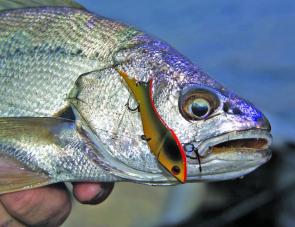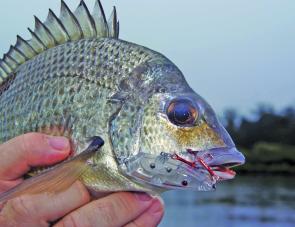Now we're well and truly out off the gloom of Winter and looking at much better things to come. The first thing to improve around these parts was the weather and after certainly the wettest and coldest Winters I've seen up this way, thankfully it's gone.
The next thing to improve is the run of snapper. Locals are saying this is the best run of reds they have seen for years.
One fellow told me it's the best run of snapper he's ever seen.
There have been plenty of fish of a kilo to 3kg, with a really good sprinkling of 4kg to 7kg fish and I've heard of a few up around 9kg.
As usual, most of the action is on the northern reefs.
There have been good reports from Grassy Head north all the way up towards Nambucca, though most anglers tend to fish around Grassy to Scotts heads.
It seems there are good numbers of snapper in shallow as well as out on the deeper reefs in 40m.
For the bait crew, get a good berley trail happening and send out lightly weighted pilchards or squid.
For the lure guys, get out super-early and fish the shallow country with 7” Gulps or 6” Squidgy Flick Baits.
Those heading south can still expect to find a few reds, though you will be fishing much deeper country – 36 fathoms.
If you want to head south yet are not overly keen to fish the deep reefs off the lighthouse, try Black Rock and Fish Rock. While there's not a great deal of reef around either island, some very good snapper can be taken.
Those heading south also get to mix it with the kingfish population. Fish and Black rocks hold kings and usually some crackers, too.
At this time of year they seem to come in two sizes – small and huge. It seems the 5kg to 9kg fish thin out and are replaced by either salmon-sized kings or real thumpers of 14kg-plus.
The catalyst for the big kings at this time of year is the salmon run.
Salmon have become the new mullet.
Wild stocks of sea mullet are over-fished very heavily each year by beach haulers and as the mullet disappear, the commercially non-viable salmon (they mustn’t be netted north of Barrenjoey) have taken the mullet’s place as the No 1 inshore baitfish.
This is nature’s way of balancing up man’s insatiable greed, but as soon as there's a dollar price put on the ubiquitous salmon, they too will meet the same fate as the humble mullet.
As it stands, the salmon are safe for this season and there are good numbers cruising the beaches and headlands.
If you want some true sport fishing fun, grab a light spin rod and a few metal slices and the hit the beaches or headlands early or late in the day.
If you want a feed of top-shelf seafood, let all your salmon swim free.
While salmon aren't inedible, they are pretty average on the plate. A smoker may be the answer; I'm yet to try smoked salmon but those who have say it's quite good.
In the Macleay River the fishing is still a bit of a struggle. In fact it hasn't been very good for nearly four years.
Excessive beach hauling and estuary netting on spawn-run fish have taken their toll and the once healthy Macleay is really a shadow of its former glory.
While it's not totally fishless – you will still find a few decent fish if you put in the effort – compared with only a handful of years back it's in a pretty sad state.
The frustrating thing is that I, like many anglers, moved here for the exceptional fishing. My main interest was the run of mulloway, and while it's still possible to catch them fairly regularly, the average size has shrunk alarmingly.
Twenty years ago a 20kg jewfish was common and the average size was 15kg to 18kg.
Only 10 years ago the average size had shrunk to around 8kg to 10kg and five years ago the average fish was around 6kg to 8kg.
Now the average size is 1kg to 4kg.
DPI Fisheries knew mulloway numbers were unsustainable for commercial fishing 13 years ago, yet nothing has been done. Quite simply, mulloway should be made a recreational species only.
If you feel the same way, send an email to Katrina Hodgkinson at --e-mail address hidden--
It's essential that those who represent us are aware of how dangerously low fish stocks are becoming.
On a more positive note, bass anglers are in a far more positive state. Unlike many saltwater species, bass numbers have remained very stable on the Macleay River.
That’s not surprising, really, because most recreational anglers wouldn't think of killing one to eat and commercial fishers are aren't allowed to target or sell them.
Now if DPI Fisheries could extend the same grace and commonsense to the once-mighty mulloway, we would see these amazing fish return in healthy numbers from the brink of extinction.
For those in charge, don't leave it too to make a decision!
Reads: 5878
An average-sized Macleay River jewfish. The author says this 1.5kg schoolie is considered average around these parts, due to legal over-fishing and DPI Fisheries mismanagement.

Bream are on the wane in the Macleay, with Phil Bennett’s good outings over the past four years yielding half a dozen keepers. Only 10 years ago they were in terrific numbers up and down the coast, he says.

Lucky bass are still in good numbers in the Macleay, thanks to some wise management from DPI Fisheries many years ago. The author says now is time to apply these same regulations to decimated saltwater species like mulloway and bream.




